ULTRA SYSTEM HI-FI TUNING FUSE
| ULTRA SYSTEM HI-FI TUNING FUSE |
| Careful what you pray for |
|
|
|
December 2007 |

When I was asked by Clement Perry to review a particular piece of audio gear, I naturally thought in terms of speakers, amps, cables, etc. Imagine my surprise when the gear in question turned out to be a set of fuses. Fuses! I was of course aware of equipment modifications as an adjunct to the more typical paths to audio nirvana, namely trading, new purchases, and upgrading. There are a number of competent modification professionals who typically use better but often more expensive parts. As a result, the costs for their modifications can be a significant fraction of the gear’s original selling price.
What can I possibly say about a fifteen cent fuse I thought to myself.
Let’s see, “it’s a small round electrical device approximately 1.5 inches long, that interrupts the flow of electrical current when overloaded.” End of story, I imagined. My curiosity aroused, I agreed to write the review, promising myself to keep an open mind, but to be honest, I felt this assignment would be a very short lived experience. As it turns out, I was not in any way prepared for what took place once I examined and critically listened to the Ultra Systems Hi-Fi Tuning Fuses I installed in my McIntosh MC-501 monoblocks.
Prior to the Ultra Systems Hi-Fi Tuning Fuse’s arrival at my house, I began to think of how I would test these items. First, I thought of doing a blind test, followed up with an “A-B” test, to compare existing stock fuses with the Ultra Systems Hi-Fi Tuning Fuses. Nothing else came to mind other than waiting for the new fuses to pass current to ensure they operate correctly. Not one to go into any challenge blindly I decided to do some pre-review fact gathering, to better prepare myself for the review, and get motivated. I was not trying to prematurely knock the product before giving it a chance; however, my expectation meter was not at its highest. After all, these are only fuses.
The collected information on the Ultra Systems Hi-Fi Tuning Fuse was unlike that of any other fuse I have ever encountered. Some of the important facts I learned about them are as follows: Each individual Fuse is built by hand and individually tested in Germany; the usual glass casing is replaced with a ceramic material for increased resonance control; the thin aluminum wiring found in your normal low cost fuse is replaced with a pure silver wiring filament. To complete the process the Fuses are sealed with a 24K gold end cap. In reading this, I couldn’t help but think “all this for a fuse?”, but it made more sense when I changed my mindset and considered the fuse as an electric component. I also learned from their site that these Fuses are available in several different sizes (large and small), types (fast and slow blow), and amperages. Whatever size fuse your system requires, there is a Hi-Fi Tuning Fuse available.
Initially I ordered the incorrect size: The McIntosh required small slow blow “T” type, not large slow blow types. I contacted Mr. Robert Stein at Ultra Systems Inc. and within a few days I received the correct models. To my surprise, there is something very special about this product. These contraptions don’t look and feel like the normal fuses we deal with everyday. Upon closer observation and feel, the Ultra Systems Hi-Fi Tuning Fuses felt heavier mainly because of an enhanced quality construction; just the feel alone prematurely validated the information I gathered through my research. But I still had the task of finding out what affect if any they would have on my system.
Prior to changing out the factory installed stock fuses in my MC-501 monoblocks I contacted McIntosh technical support seeking information as to the proper procedure for changing the fuses, and to verify that these amps only have one slow blow “T” type fuse per monoblock. Upon receiving the requested information from the technician I decided to proceed. I powered down my MC-501 monoblocks, unplugged them from the wall, removed each stock fuse, and compared them to the Ultra Systems Hi-Fi Tuning Fuses. Yes, the Ultra Systems Fuses are definitely a much improved, better constructed fuse than the fuses I pulled out of the MC-501’s. But would they sound better?
 Installation was a breeze – pop out the existing factory installed stock fuse, pop in the Ultra Systems Hi-Fi Tuning Fuse. Finally, I was ready to do my thing. I went to the fridge to get a cold drink, picked out a familiar test CD (I used contemporary jazz group Fourplay’s Heartfelt CD), dimmed the lights and let the testing begin. Well, so much for all my testing schemes, once I powered up my McIntosh monoblocks and the music started; all my previous testing plans instantly went straight out the window. After listening to a few tracks all I could think was “Are these the same amps I purchased a couple of years ago, or did someone knock me out and switch my equipment?”
Installation was a breeze – pop out the existing factory installed stock fuse, pop in the Ultra Systems Hi-Fi Tuning Fuse. Finally, I was ready to do my thing. I went to the fridge to get a cold drink, picked out a familiar test CD (I used contemporary jazz group Fourplay’s Heartfelt CD), dimmed the lights and let the testing begin. Well, so much for all my testing schemes, once I powered up my McIntosh monoblocks and the music started; all my previous testing plans instantly went straight out the window. After listening to a few tracks all I could think was “Are these the same amps I purchased a couple of years ago, or did someone knock me out and switch my equipment?”
Hold on, time for a reality check. Could the Ultra System Hi-Fi Tuning Fuses really be that good? I have always tried not to let first impressions be the ultimate factor whenever reviewing a product. Yes, I was impressed to say the least, and yes, these devices were an eye opener, but to be fair, I had to asked myself, “What exactly in the past two hours did I experience?” I will begin with the following impressions: “Improved clarity,” to the point reminiscent of fine tuning an already well tuned automobile, the kind of satisfaction you feel when you finally get that engine to purr like a kitten with every gentle hand stroke applied.
While listening to Heartfelt, the improved clarity of each instrument was phenomenal. One example was Larry Carlton’s hypnotic guitar solo on track 10 “Making up.” It was very easy to follow every string pluck, allowing me to fall deeper into every solo he masterfully performed throughout. Also improved was the imaging, whereby each musician had his own space; no longer were Harvey Mason’s kick drum beats blending unnaturally with Nathan East bass guitar notes. I could now distinctively separate the two musicians’ instruments without any strain whatsoever. Bob James’ keyboards sounded like, well, like the incomparable Bob James second to none – articulate, smooth, very tasteful. All of these qualities were accompanied by increased dynamics, the overall musical presentation was more natural, extremely realistic, and enjoyable as a whole, resulting in a totally pleasurable and relaxed listening environment. Listening fatigue was virtually eliminated and a new musical experience was introduced.
However, as Lee Corso (college football broadcaster and former coach) often animatedly says “not so fast!” Prior to becoming conclusive with my initial findings, I decided to conduct additional tests to validate my initial findings. I made the decision to remove both Ultra System Fuses and reinstall the stock fuses, then listening to the same CD a few more times. So I took a seat, grabbed the remote, and pushed the play button. It didn’t take long to discover that everything went back to the way it was in the pre Ultra Fuses days.
My system was back to normal. Yes, it was still splendid as usual, however not as dramatic as with the Ultra Systems Hi-Fi Tuning Fuses installed. I could feel something was missing; a small portion of that lively energy had disappeared. With the removal of the Ultra Systems Fuses I noticed that the overall texture of the music changed ever so slightly, that added burst of excitement having vanished. Dynamics now sounded a wee bit toned down, the overall clarity seemed ever so slightly dulled, and instrument spacing was not as airy as before, sounding to some extent condensed. Needless to say, I wanted that missing extra bit of a musical rush to return. The Ultra Systems Hi-Fi Tuning Fuses will be reinstalled into my monoblocks, and this time, to stay.
To sum up my experiences in a macro sense, with the Ultra Systems Fuses in my system, it was as though I was listening to the group Fourplay for the very first time, even though I have listened to that CD dozens of times over. Impressed (fully), shocked (extremely), pleased (totally). May I also mention that nothing about this experience was subtle; everything I previously experienced increased my “Wow Factor” to yet another level. All these improvements came with a very small price attached. I cannot recall in my audiophile life any tweak with such a small and seemingly inconsequential price tag produce such encouraging results.
Conclusion
As I once, along with others, believed fuses were merely installed to protect valuable equipment from a damaging over voltage condition. I highly recommend the purchase of a few Ultra Systems Hi-Fi Tuning Fuses for your entire system. I am convinced you cannot lose by giving these wonderful devices a try. At $29.95 for the small size or $34.95/large sizes, they absolutely have to be one of the best low cost tweaks I have ever experienced.

________________
Specifications:
Features:
* hand made and tested in Germany
* gold over silver end caps
* pure silver wiring
* ceramic casing, rather than glass, for better resonance characteristics.
Price:$24.95 – $34.95
Contact: http://www.ultrasystem.com
![]()
Don’t forget to bookmark us! (CTRL-SHFT-D)
Stereo Times Masthead
Publisher/Founder
Clement Perry
Editor
Dave Thomas
Senior Editors
Frank Alles, Mike Girardi, Key Kim, Russell Lichter, Terry London, Moreno Mitchell, Paul Szabady, Bill Wells, Mike Wright, Stephen Yan, and Rob Dockery
Current Contributors
David Abramson, Tim Barrall, Dave Allison, Ron Cook, Lewis Dardick, Dan Secula, Don Shaulis, Greg Simmons, Eric Teh, Greg Voth, Richard Willie, Ed Van Winkle, and Rob Dockery
Music Reviewers:
Carlos Sanchez, John Jonczyk, John Sprung and Russell Lichter
Site Management Clement Perry
Ad Designer: Martin Perry





Be the first to comment on: ULTRA SYSTEM HI-FI TUNING FUSE